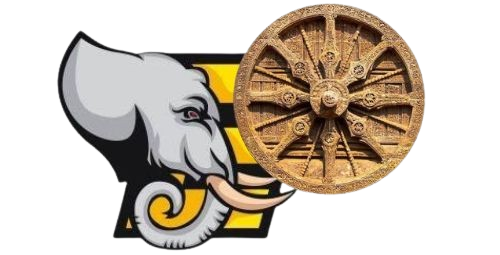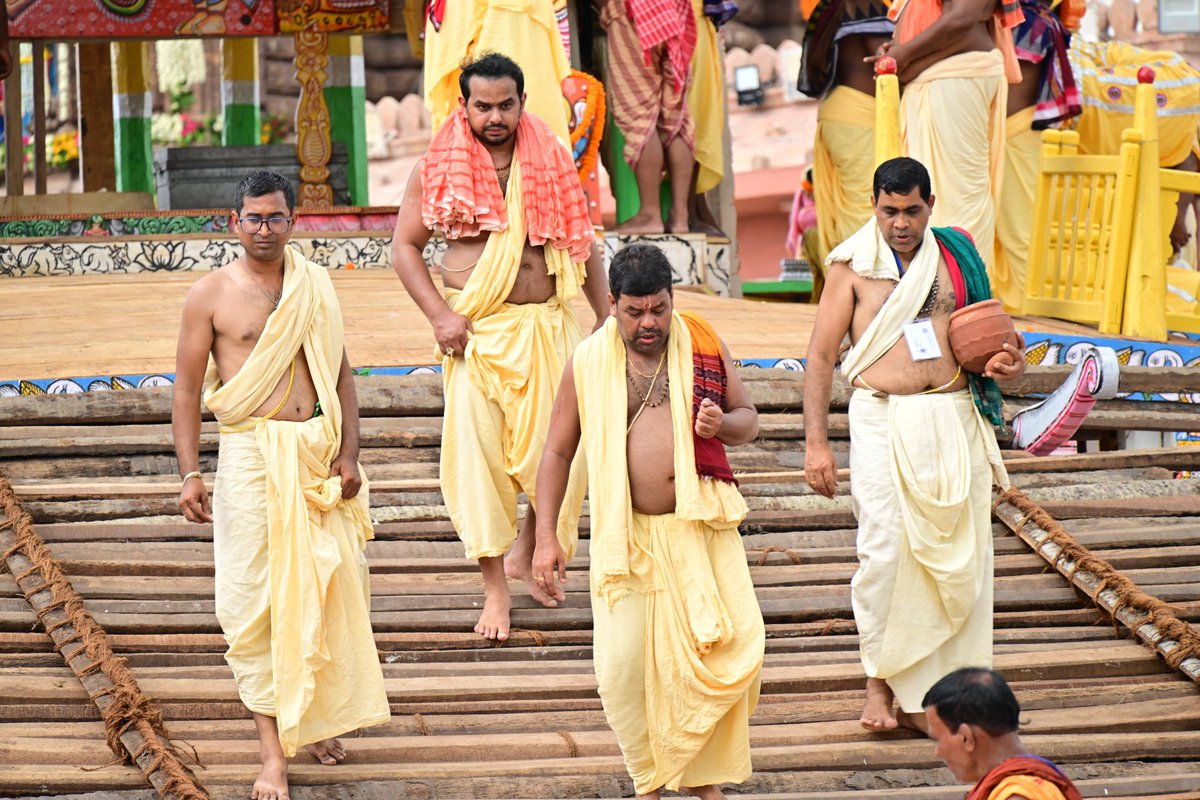The sacred city of Puri, Odisha, is home to the Jagannath Temple, one of the most revered pilgrimage sites in the Hindu world. Here, the Lord of the Universe—Sri Jagannath—resides not in silence or solitude, but in the heart of a living tradition bustling with ritual, devotion, and service. Unlike many other Hindu temples where the deity is served by a limited priesthood, Lord Jagannath’s temple is distinguished by the presence of thousands of hereditary servitors, known as “Sevakas”, who perform a multitude of daily and seasonal duties.
These sevakas are not just priests or temple workers. They are caretakers, musicians, cooks, protectors, charioteers, carpenters, and ritual specialists, each bound by centuries-old traditions passed down through generations. Their origin, responsibilities, and sacred role in the living culture of Jagannath worship represent an intricate and fascinating system of divine service.
Origin of the Sevaka Tradition in Jagannath Culture
The origin of Jagannath’s servitorship dates back to ancient times, believed to be established formally during the rule of the Ganga dynasty, particularly under King Anantavarman Chodaganga Deva in the 12th century, who is credited with building the present-day Srimandir (Jagannath Temple). Over time, the number of servitors expanded as rituals grew in complexity.
Unlike other temples where priesthood is centralized, the Jagannath temple follows a multi-tiered system of service, involving ritual, administrative, and functional roles. This vast and highly organized system became more structured during the reign of the Gajapati kings, who served as the temple’s chief patrons and were considered the first servants (Adya Sevaka) of the Lord themselves.
The temple operates not as a place of worship alone, but as a cosmic court, with Lord Jagannath as the reigning monarch. Thus, his servitors are considered royal functionaries, each with a unique title, responsibility, and religious status.
How Many Sevakas Does Lord Jagannath Have?
As per the Jagannath Temple Record of Rights (1872) and updated documentation by the Puri Temple Administration, there are approximately 5,000 to 6,000 sevakas associated with the Jagannath Temple. However, about 1,200 to 1,500 are actively involved in the daily rituals and annual festivals, while the rest participate during major ceremonies like Rath Yatra or Nava Kalebara.
The sevakas are classified into 140+ different service categories, each with specific duties. They are broadly divided into three types:
- Niti Sevakas – Performers of daily and periodic rituals
- Bhoga Sevakas – Cooks and kitchen workers responsible for preparing Mahaprasad
- Paricharika Sevakas – Helpers, guards, palanquin bearers, and those managing temple logistics
These services are considered hereditary and sacred, often passed from father to son, maintaining an unbroken lineage of devotion for centuries.
Major Sevaka Categories and Their Duties
Here is a detailed overview of the primary classes of Jagannath’s sevakas and their divine responsibilities:
1. Daitapati Sevakas
Origin: Believed to be descendants of Viswabasu, the tribal chief who originally worshipped Lord Jagannath in the form of Nila Madhava.
Role:
- Perform sacred duties during Nava Kalebara (body transformation ritual of deities)
- Responsible for Banajaga Yatra, the search for the sacred neem trees (Daru)
- Carry the deities during Pahandi Bije (procession to the chariots)
- Only sevakas allowed to touch the deities during their “mortal” phase
Significance: Represent the tribal roots of Lord Jagannath worship, highlighting the syncretism of tribal and Vedic traditions.
2. Pujapanda Sevakas
Origin: Brahmin priests trained in Vedic and Tantric rituals
Role:
- Perform daily puja, archana, alati, mantra chanting, and abhishekam
- Supervise various nitis (rituals) such as Mangala Arati, Mailam, and Sandhya Dhupa
- In charge of offering bhoga (food) to the deities multiple times a day
Significance: They ensure the spiritual sanctity and continuity of the daily worship of Lord Jagannath.
3. Suara and Mahasuar Sevakas
Origin: Traditional cooking communities of Odisha
Role:
- Prepare Mahaprasad in the temple’s Ananda Bazaar, one of the largest kitchens in the world
- Cook over wood-fired earthen ovens using sacred pots and ingredients
- Ensure purity and Vedic compliance of all offerings
Significance: Their service ensures the nourishment of the deity and of lakhs of devotees daily.
4. Patimohapatra and Taluchha Mohapatra
Role:
- Handle sacred ornaments, attire, and decoration of the deities
- Arrange Beshas (divine attires), such as Suna Besha, Hati Besha, and Raja Rajeswari Besha
- Maintain security of the jewellery and manage the dressing chambers
Significance: Their skill preserves the visual majesty and royal grandeur of Lord Jagannath.
5. Ratha Sevakas (Car Festival Servitors)
These include several groups who only serve during Rath Yatra, such as:
- Bhoi Sevakas – Rope bearers and chariot handlers
- Lenka and Daita Mahapatra – Help carry and protect the deities during transfer
- Chitrakaras – Paint the chariots with symbolic motifs annually
- Viswakarmas – Carpenters who build the chariots from scratch every year
Significance: Their coordination and hard work manifest the grandest spiritual spectacle in the world—the Rath Yatra.
Hierarchy and Ritual Purity
Despite the large number of servitors, the Jagannath temple follows a strict hierarchical and ritual protocol. Every seva (service) is regulated by ancient scriptures such as the Niladri Mahodaya, Madala Panji, and temple tradition.
Each sevaka:
- Must maintain ritual purity before service
- Is restricted to certain areas of the temple
- Must follow fixed timing and procedures
- Is trained in oral traditions and family-based knowledge systems
The Gajapati Maharaja of Puri is considered the Adya Sevaka (first and chief servant), highlighting the philosophy that even kings are but servants before the Lord of the Universe.
Spiritual Philosophy Behind Jagannath’s Sevakas
The system of sevakas is deeply embedded in Jagannath culture’s inclusiveness. Unlike other temples restricted to Brahmins, the Jagannath Temple embraces a pluralistic system, where people of varied castes and communities have essential roles.
This reflects the spiritual philosophy of Lord Jagannath as a deity who transcends caste, color, or creed—a “God of the people”, whose temple remains one of the most democratic spaces of devotion in Hinduism.
Challenges and Preservation
In modern times, the traditional sevaka system faces challenges:
- Generational discontinuity
- Economic dependency on temple offerings
- Conflict between tradition and administration
- Increasing need for reform and digitization
However, efforts are being made to preserve this living tradition through better documentation, legal rights for sevakas, training, and historical awareness.
Conclusion
The sevakas of Lord Jagannath form the lifeblood of one of India’s oldest living religious institutions. Their rituals, duties, and lineages represent not only acts of service but expressions of devotion, identity, and timeless tradition. They serve not merely to perform tasks, but to uphold the spiritual rhythm of a divine kingdom where Lord Jagannath is king, and they are his eternal attendants.
In understanding the lives and roles of Jagannath’s sevakas, one does not just explore temple mechanics, but the soul of Odia culture, where faith is lived, inherited, and performed every single day.


